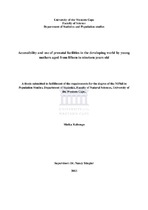| dc.description.abstract | Background: Professional health assistance is a significant indicator in monitoring progress towards Millennium Development Goal five to reduce the maternal mortality ratio by three quarters and child mortality by two-thirds between 1990 and 2015. It is also significant that mothers deliver their babies in an appropriate setting, where life saving equipment and hygiene can also help reduce the risk of complications that may cause death or illness to mother and child. But in developing countries access to health services is still an issue. Objective: From a fundamental research view point, this study aims to investigate the determinants of place of delivery and professional health providers by analysing the factors
that are likely to influence young mothers’ accessibility and use of prenatal facilities in the developing world. Specifically in Kenya, Ethiopia, Nepal, Bangladesh, Guyana and Haiti. Methodology: Univariet and bivariet analysis were performed to determine a relation or association between dependent and independent variables. Using secondary data from Demographic and Health Survey secondary data requested from the DHS selected between 2005 and 2010, the analysis was performed by means of SPSS software. Bringing together the demographic variables and access and the use of health services related variables, the
study captures the differences and similarities across these countries.
Results: The study has identified the main factors influencing the use of professional health providers and health facilities according to the variables examined from the DHS. The finding showed the use health facilities for delivery, professional health providers were influenced by economic status of young mothers, level of education, place of residence, religion, marital status, in all six countries. Access to health facilities was much influence availability of transport, the presence of health providers at facilities and availability of drugs at facilities. Family members’ knowledge about the importance of delivering a baby at health
facilities was found to be the strongest predictors of use of health facilities for delivery in all six countries. These findings suggest that these factors cited are associated with access and use of professional health providers and health facilities, and should be the target of interventions aimed to increase the use of prenatal facilities and professional health providers among young women in these countries in order to improve maternal and child health in accordance with Millennium Development Goals four and five. | en_US |

